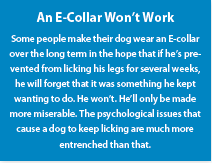Your dog won’t stop licking one of his front legs to the point that there’s a significant abrasion at or above his “wrist” (carpal joint). It looks like a big open sore, with the fur eaten away right down through the skin. You keep telling him to leave his leg alone, but he simply cannot; he seems compelled to keep licking. You’ve taken him to the vet, who has prescribed different antibiotics for a possible infection as well as anti-inflammatories to take down swelling around the area. And those medications seemed to help a little, but then he was right back to licking and re-opening the wound. What’s going on?
The dog is likely suffering from what is known as acral lick granuloma, sometimes called acral lick dermatitis. “Acral” is the medical term (for people, too) for the body’s extremities (including the lower limbs). And a “granuloma” is a lesion that looks raised and inflamed.
The condition commonly strikes large and medium-size dogs. Dogs weighing fewer than 40 to 50 pounds are less typically afflicted. Sometimes acral lick granuloma occurs on an “ankle” — the lower part of a back leg, termed the tarsal joint — but the “wrists” on the front legs are more generally involved. More than one leg may be affected.
“It can be a very tricky and challenging condition to treat,” says Tufts veterinary dermatologist Ramón Almela, DVM. “Several things may overlap — a psychological problem that manifests itself as a compulsion to keep licking, an infection, maybe an allergy, joint pain, or a combination of factors. It can take many months to get to the bottom of it, and in some cases people with dogs have gone for years without getting to the roots of the problem. In the meantime, the lesion only worsens as the dog keeps licking, perhaps setting the scene for more severe infections. It becomes a vicious cycle,” Dr. Almela says.
Part of what makes it tricky to treat, he comments, it that it’s very often a chicken-and-egg issue. You don’t know how it started. Sometimes a dog just begins licking out of nowhere — a behavioral issue — and then an infection develops because bacteria colonize at the open wound. Or a dog may be bitten by an insect and starts licking to relieve the itching the bite has caused. The bite heals, but the licking continues.
A two-pronged treatment approach
A dog with acral lick granuloma, especially if he has already been taken to the doctor but the prescribed treatment hasn’t worked, should ideally see both a veterinary dermatologist and a veterinarian who is board-certified in animal behavior, Dr. Almela says. “This could be expensive up front,” he concedes. “But the dual approach is more likely to lead to lasting success than Band-Aid solutions that work only for a little while. In the end, it doesn’t matter which came first — the medical issue or the psychological one. They both need to be resolved.”
Medical work-up. A primary care veterinarian or a veterinary dermatologist may take a small piece of tissue from the wound and culture it to see what bacteria may be colonizing at the site. Then he can prescribe the most effective antibiotics for the types of bacteria present. He may also prescribe an anti-inflammatory drug to reduce swelling. These steps may provide some relief quite quickly
Additionally, the doctor might order x-rays to rule out arthritis or inflammation of the underlying bone. Those problems can contribute to itching and subsequent licking, too. Not only does a dog “scratch” an itch by licking, he might also lick in response to pain.
Along with checking to see if the problem involves a bone or joint, the vet may look to see whether the dog is suffering from a flea or tick bite or perhaps an allergy. It’s very common for a dog to react to airborne allergens such as mold and pollen by licking his legs and feet.
Behavioral workup. A veterinary behaviorist will know whether the breed of dog affected

No matter what the breed, the behaviorist will also take a deep dive into the dog’s lifestyle. Does he get enough physical activity and play time or does he lead a boring life? Does he have separation anxiety or other things that leave him feeling particularly stressed? In other words, at the same time that the dermatologist is treating the medical causes of the licking, the veterinary behaviorist will be tending to the psychological triggers. She may prescribe lifestyle changes that include much more environmental enrichment or a combination of lifestyle changes and mood-calming medications.
It’s that double-barreled approach — getting at the physical reasons for the itching along with the psychological ones — that can stop the ongoing licking once and for all, Dr. Almela says. If you don’t get to all the issues, he points out, the dog may find himself right back in the cycle, with the medical problems feeding the psychological ones and vice versa.





